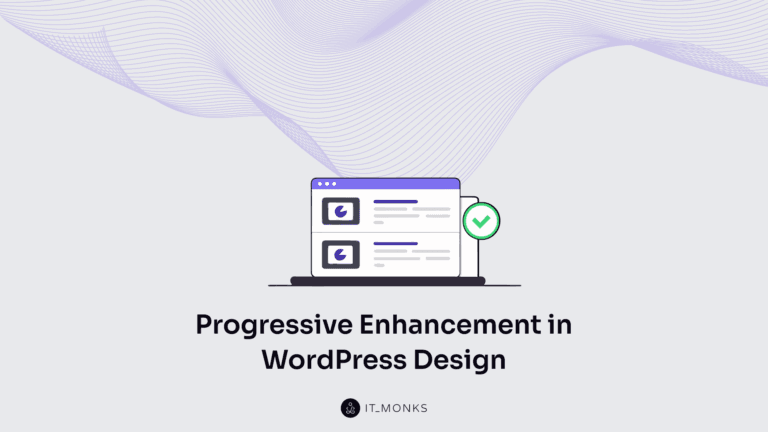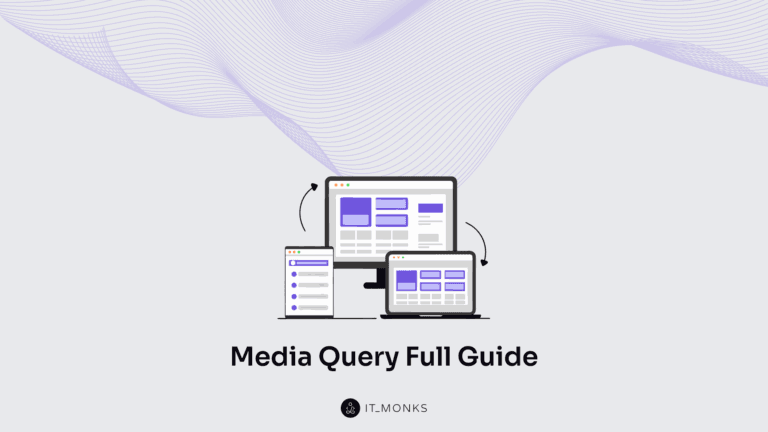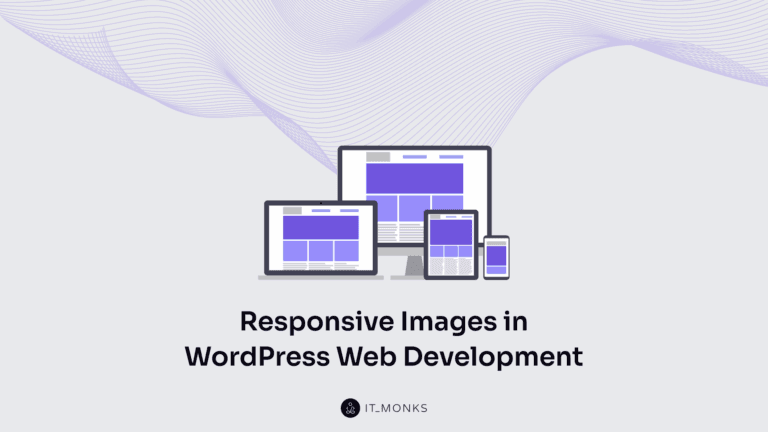What is Backend in WordPress?
Table of Contents
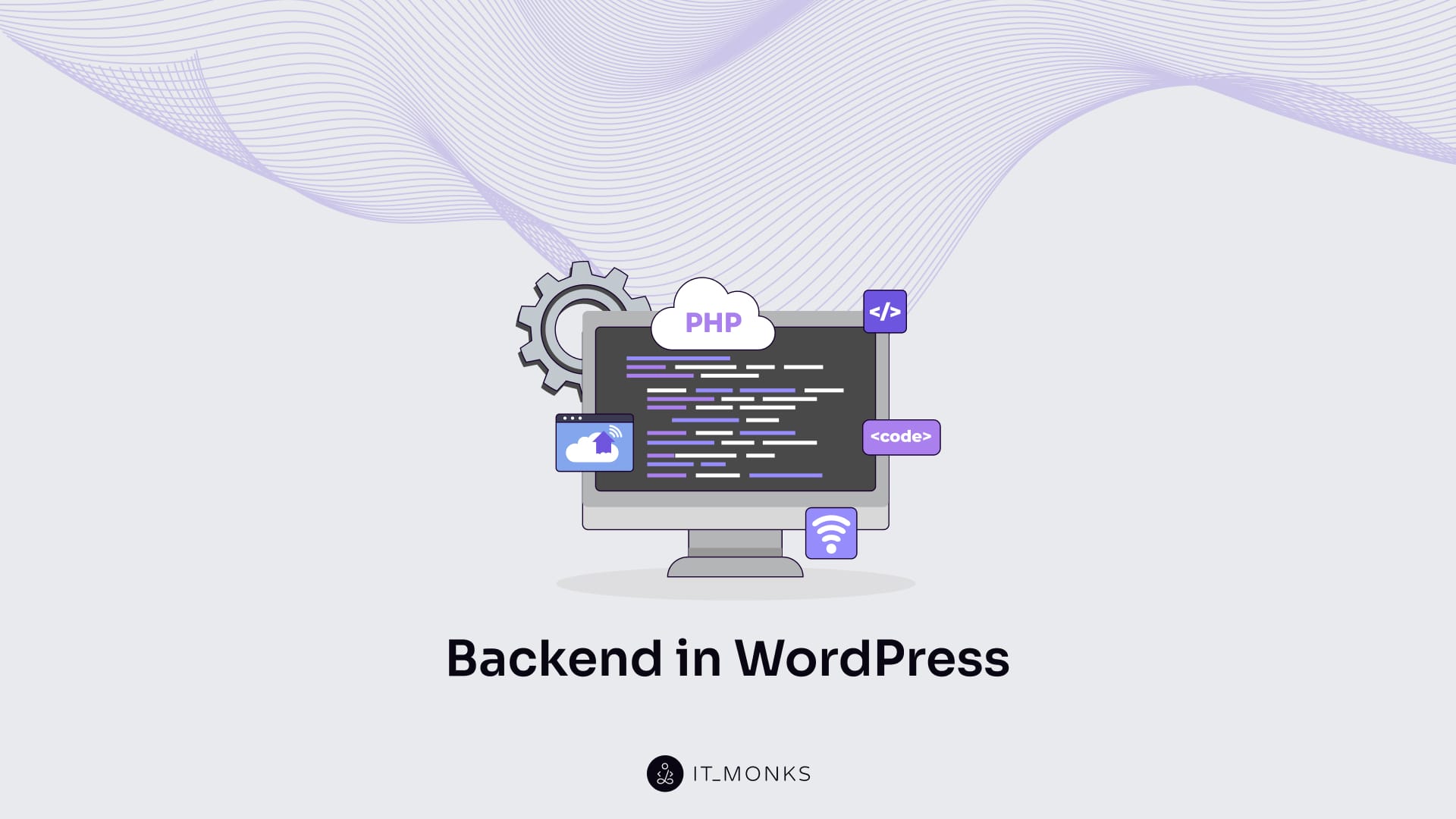
The WordPress backend is the server-side environment of a WordPress website, accessed through the wp-admin dashboard. It serves as the administrative control panel, where site owners and developers manage content, configure settings, and control user access before any content appears on the public-facing frontend.
At its core, the backend handles:
- Content management: creating, editing, and organizing posts, pages, and media.
- User roles and permissions: defining who can do what within the site.
- Site-wide configuration: controlling plugins, themes, menus, and general settings.
- Security and compliance: restricting unauthorized access and protecting sensitive data.
From a technical perspective, the backend executes PHP logic, communicates with the database (MySQL/MariaDB), and supports API integrations. This environment processes requests, validates inputs, and ensures that data remains consistent and secure.
The backend also provides extensibility, allowing developers to enhance WordPress using hooks, custom post types, and APIs without modifying core files. This modular design makes WordPress flexible for projects ranging from simple blogs to enterprise-level applications.
What is the Difference Between Backend and Frontend?
The WordPress backend and WordPress frontend are two distinct but interconnected layers that power a WordPress website.
- The backend, accessed through the wp-admin dashboard, handles administrative tasks such as user management, global settings, plugin logic, and database operations.
- The frontend is the public-facing side of the site, i.e., what visitors see and interact with in their browser.
The backend works behind the scenes, requiring authentication and operating in a secure environment. Here, administrators configure the site, process dynamic content, and control how themes and plugins behave. The frontend then takes those outputs and renders them visually using HTML, CSS, and JavaScript, shaping the site’s layout, navigation, and media presentation.
This separation of responsibilities creates a clear boundary: administrators manage and configure content in the backend, while visitors interact with the finished product on the frontend. Backend logic structuring ensures stability and performance, while frontend development in WordPress focuses on design, interactivity, and user experience.
Core Functions of the WordPress Backend
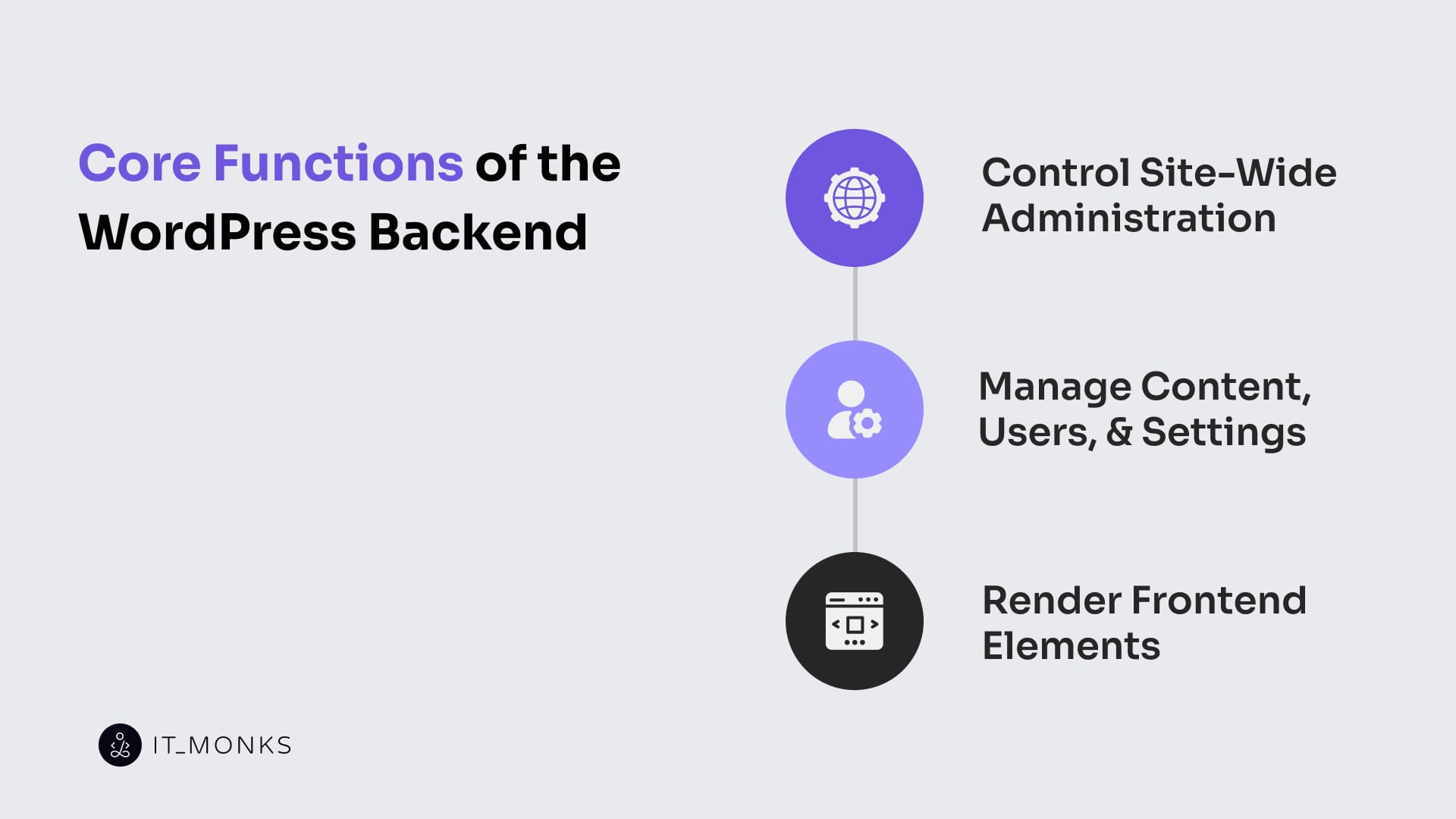
Control Site-Wide Administration
The WordPress backend is the command center of a WordPress site, accessed through the wp-admin dashboard. From here, administrators manage global operations, including plugin activation, theme configuration, and system updates. These actions impact the site as a whole, shaping its performance, security, and appearance across every page.
Through the backend, administrators also regulate user access, enforce security protocols, and maintain compliance with versioning standards. Settings made in this environment cascade throughout the site, determining how resources are loaded, how content behaves, and how backend logic is executed.
Manage Content, Users, and Settings
Beyond system administration, the backend functions as the primary hub for content and user management. Administrators and editors create, organize, and update posts, pages, media, and custom post types, forming the site’s informational structure.
The backend also manages user accounts by assigning roles, permissions, and editorial privileges, ensuring a secure and orderly workflow. Global settings (including reading preferences, permalink structures, and privacy options) are also configured here, shaping how the website operates at scale.
Render Frontend Elements
While the frontend is what visitors see, its structure is ultimately generated by the backend. Through server-side processing, the backend retrieves stored content and merges it with theme templates, producing formatted HTML, CSS, and JavaScript that render in the user’s browser.
The template hierarchy and backend logic determine which layouts are used, how components appear, and under what conditions specific features are loaded. Every visible page, from blog posts to landing pages, is dynamically generated in this way, making the backend the source of the frontend experience.
Role of wp-admin in Backend Development
The wp-admin panel is the primary interface of the WordPress backend, providing administrators with secure access to configure and control the site. As the gateway to backend operations, it centralizes all key functions, including plugin activation, user management, content organization, and global settings.
This WordPress admin dashboard serves as a dynamic, role-based environment where visibility and control are determined by assigned permissions, ensuring that only authorized roles can execute system-wide changes. Through this interface, administrators trigger backend scripts, apply configuration updates, and oversee workflows that directly affect site performance, security, and content delivery.
Provide Access to Backend Operations
The wp-admin interface provides structured access to the backend environment of a WordPress website, enabling administrators to initiate and execute system-level operations securely. As the default entry point into the WordPress backend, it governs all administrative interactions, serving as the path through which backend functionalities, such as content updates, plugin controls, and site configuration, are accessed.
This access is both exclusive and authenticated, permitting only authorized users to interact with the system’s operational core. Whether adjusting global settings or managing user roles, every backend function is gated behind the controlled layer of wp-admin. The admin interface, therefore, acts not merely as a login route, but as the first operational checkpoint in backend administration, defining who can enter and what can be done once inside.
Authenticate and Authorize Admin Users
wp-admin authenticates and authorizes admin users as a prerequisite for accessing the WordPress website’s backend. It verifies login credentials to ensure the identity of the user attempting to enter the backend environment and simultaneously assigns permissions that define their operational scope.
Through authentication, wp-admin confirms that only legitimate users gain entry, while authorization governs the specific administrative privileges granted based on defined roles. These two sequential safeguards (identity verification and permission enforcement) uphold the security of backend operations by restricting access to approved personnel only.
Serve as the Interface for Site Administration
wp-admin functions as the core interface for managing and administering a WordPress website, acting as the structured layer through which all backend operations are performed. It enables site administrators to interact with the system’s internal architecture, governing content workflows, user roles, configuration settings, and site behaviors.
As part of the WordPress backend, wp-admin delivers a navigable environment where operational tasks are executed via an organized admin dashboard. This environment supports both day-to-day and systemic changes to the site’s infrastructure, making wp-admin the functional space where backend logic is applied to real-time administrative actions.
Customizing the WordPress Admin Interface
The WordPress admin interface, accessed through wp-admin, can be customized to fit the specific needs of a site’s administrators and editors. These changes don’t alter what the backend can do, but instead adjust how tasks are presented and organized, improving usability, efficiency, and clarity in day-to-day management.
Through customization, administrators can:
- Reorder or hide menu items.
- Add, remove, or reposition dashboard widgets.
- Simplify the layout for non-technical users.
- Create role-based views so each user sees only the tools they need.
These adjustments can also support branding or streamline frequent tasks, turning wp-admin into a more intuitive workspace. Unlike frontend theming, which affects what visitors see, backend customization reshapes only the administrator experience, leaving the public-facing site unchanged.
Programming Languages for WordPress Backend
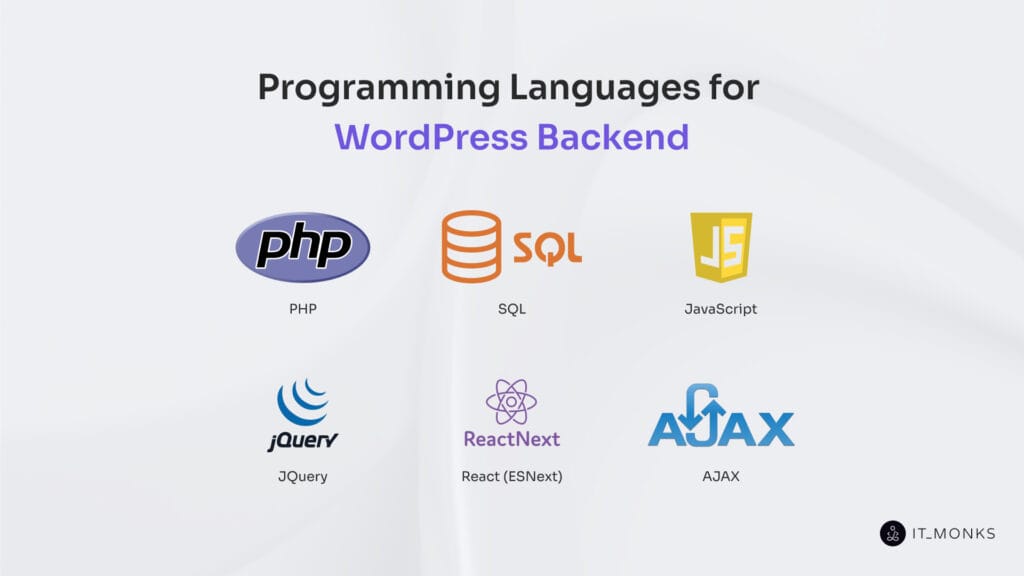
PHP
PHP is the backbone of the WordPress backend, handling the server-side logic that powers site behavior, content rendering, and database communication. Every admin action in wp-admin (from loading dashboards to saving posts) runs through PHP, which processes requests and generates dynamic web pages.
It also connects with SQL queries, manages plugin and theme functionality, and executes the backend workflows that keep WordPress operational. Without PHP, WordPress would lack the server-side engine that drives its entire architecture.
SQL
SQL is the data layer of WordPress, managing the database where all content, users, and settings are stored. Integrated through PHP, SQL handles queries that retrieve, insert, and update data in tables.
For example, editing a post, validating a user login, or updating a site option all rely on SQL queries. By structuring and organizing data, SQL ensures WordPress remains a dynamic content management system rather than a collection of static pages.
JavaScript
JavaScript brings interactivity and responsiveness to the WordPress backend. Running in the browser, it enables non-blocking actions within wp-admin, such as toggling settings, previewing changes, or validating inputs in real time.
By working alongside PHP’s server-side processing, JavaScript ensures the backend feels fluid and user-friendly, improving the day-to-day experience for administrators and editors.
jQuery
jQuery, a JavaScript library, has been bundled into WordPress for a long time to simplify admin interface scripting. It handles UI tasks such as click events, dropdown toggles, and quick animations with fewer lines of code.
Although considered legacy by modern standards, jQuery remains widely used in plugins and older components of wp-admin, making it an important part of WordPress’s backend history and compatibility.
React (ESNext)
React powers the modern WordPress backend, especially the block-based editor (Gutenberg). It provides modular, component-driven interfaces that support real-time editing, state management, and scalable UI design.
By shifting from static admin screens to interactive React components, WordPress has moved closer to a JavaScript-first architecture, giving administrators a more dynamic and consistent editing experience.
AJAX
AJAX connects the client-side and server-side by allowing asynchronous communication between JavaScript in the browser and PHP on the server. This enables saving content, filtering results, or refreshing dashboard widgets without reloading the entire page.
As a result, AJAX keeps WordPress admin workflows smooth and efficient, enabling real-time updates and background operations that improve usability.
Hook System in WordPress
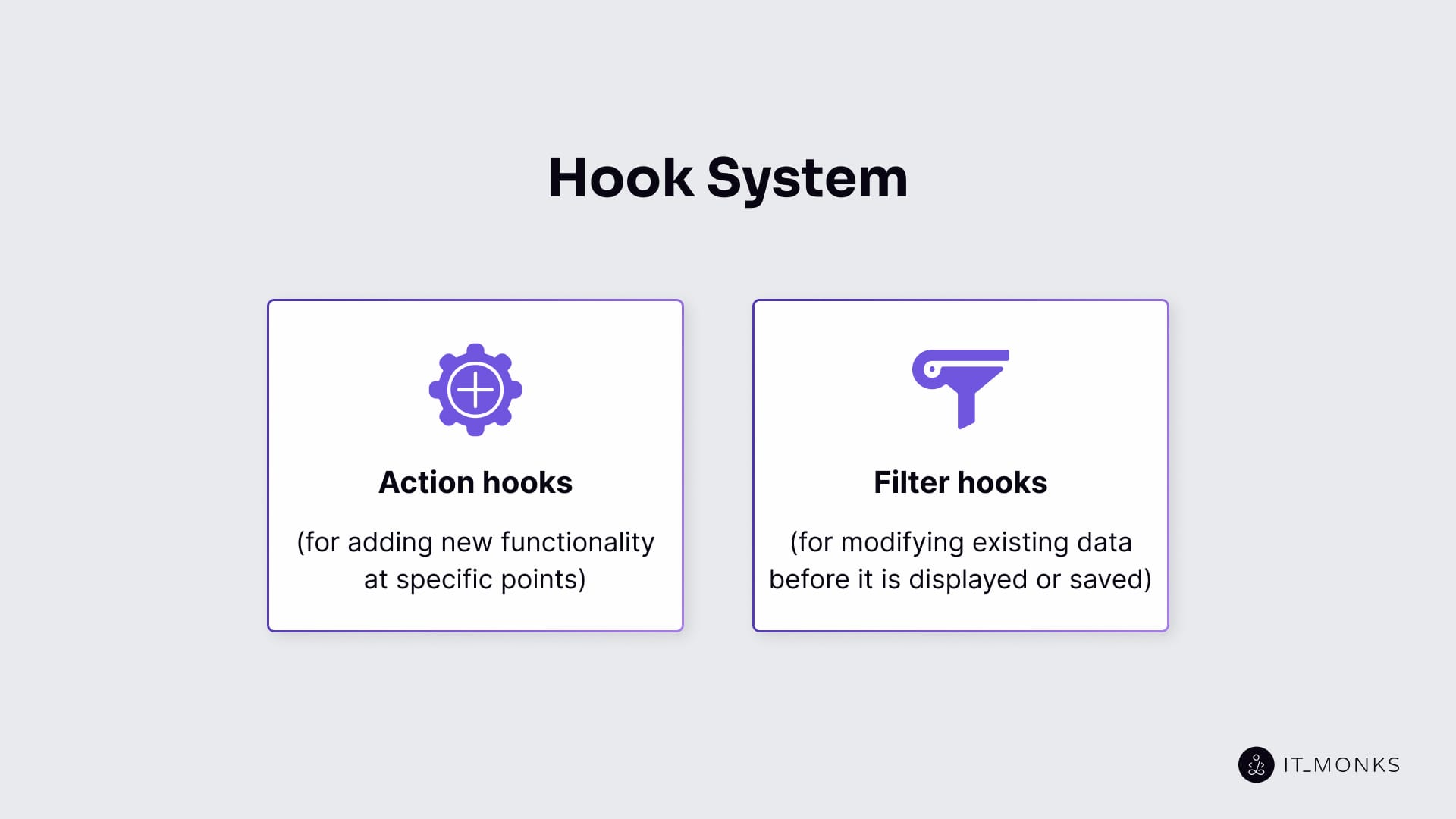
The hook system is one of the most powerful features of the WordPress backend, enabling developers to extend or modify WordPress’s functionality without editing core files. Hooks act as predefined points in the system’s execution where custom code can “hook in” and run, making WordPress flexible and modular.
Instead of being an add-on, the hook system is built directly into the WordPress architecture. It’s what allows plugins, themes, and custom functions to interact with core processes (for example, running code when content is saved, modifying form data before it’s stored, or injecting custom scripts when a page loads).
WordPress provides two main types of hooks:
- Action hooks allow you to add new functionality at specific points.
- Filter hooks allow you to modify existing data before it is displayed or saved.
Action Hooks
Action hooks are points in the WordPress backend where specific events trigger custom functions. They allow developers to attach new procedures that run during specific phases, such as site initialization, form submission, or loading parts of the admin panel.
Unlike filters, action hooks don’t change data. Instead, they add behavior at runtime. For example, you could use an action hook to send an email after a new user registers or to enqueue scripts when the admin dashboard loads.
Filter Hooks
Filter hooks enable developers to modify values as they traverse WordPress. Instead of triggering new actions, filters transform data before it is saved or displayed.
For example, a filter hook can adjust post content before rendering, modify metadata before it’s stored in the database, or change how titles appear on the frontend. This means filters operate within the data pipeline, ensuring information can be programmatically refined without touching core WordPress code.
Data Structures in WordPress Backend
The WordPress backend is powered by structured data systems that define how content, users, and settings are stored, organized, and connected across a site. These data structures act as the platform’s foundation, ensuring information is managed consistently and can be retrieved dynamically when needed.
WordPress models its data through a combination of relational hierarchies, key–value mappings, and modular storage. Posts, users, and site settings are treated as distinct entities, each with its own attributes and relationships. This separation makes the backend flexible, allowing administrators to manage different types of content, developers to extend functionality, and the system itself to scale as new data is added.
Custom Post Types and Hierarchies
In the WordPress backend, custom post types serve as data containers that allow you to define content beyond standard posts and pages. They allow WordPress to manage different entities (such as articles, media, products, or portfolios), each with its own attributes and behavior.
These post types share a common system but remain structurally independent, making WordPress flexible enough to support a diverse range of projects.
Content hierarchies extend this model by introducing parent–child relationships between posts. For example, a “Services” page may act as a parent to individual “Service Detail” pages. This supports logical nesting, content grouping, and navigation without altering WordPress’s core schema.
Metadata and Custom Fields
Metadata in WordPress stores additional information associated with content, users, or system entities. It provides context (such as author bios, featured images, or SEO descriptions) without changing the underlying database schema.
Custom fields are the practical way to add and manage this metadata. Stored as key–value pairs, they enable administrators or developers to attach dynamic attributes to posts, users, or taxonomy terms. This enables the adaptation of site behavior or presentation based on stored metadata, providing WordPress with granular control and flexibility.
Interacting with Database Tables
All WordPress data is stored in structured MySQL database tables. The backend interacts with these tables to save, update, and retrieve content, users, and settings. Internal APIs and logic layers handle most queries, ensuring consistent schema enforcement and data integrity.
This database structure enables WordPress to persist data long-term while maintaining organization, extensibility, and ease of retrieval for frontend rendering.
wp_posts, wp_users, and wp_options Overview
Three database tables form the foundation of the WordPress backend:
- wp_posts: Stores all post-based entities, including posts, pages, media, and custom post types. It acts as the central content container, connecting to metadata, taxonomies, and hierarchies.
- wp_users: Manages user accounts, authentication details, and role assignments. This table defines who can log in and what permissions they have.
- wp_options: Stores global settings, including site configuration, plugin options, and theme preferences. It ensures site-wide consistency across the backend.
Together, these tables underpin WordPress persistence, powering everything from content publishing to user management and global configuration.
User Role and Capability System
Role Hierarchy and Default Permissions
The WordPress backend controls access through a structured user role hierarchy, where each role comes with a predefined set of capabilities. This system ensures that users only perform actions appropriate to their role, keeping the backend secure and organized.
For example:
- Administrator has full control over settings, users, and content.
- Editor can publish and manage posts, including those of other users.
- Author can publish and manage their own posts only.
- Contributor can write posts but cannot publish them.
- Subscriber can manage only their profile.
Defining and Managing Custom Capabilities
Beyond default roles, WordPress also supports custom capabilities for fine-grained access control. A capability is a specific permission ( such as edit_posts, manage_options, or install_plugins) that defines whether a user can perform a task.
Administrators can add, remove, or modify these capabilities to tailor access. For instance, grant an Editor the ability to manage menus or restrict an Author from uploading media. This flexibility enables backend governance to adapt to a site’s unique workflow without requiring the restructuring of the entire role system.
By combining predefined roles with customizable capabilities, WordPress offers a scalable and secure access model that strikes a balance between site security and editorial freedom.
Security Measures in WordPress Backend Development
The WordPress backend incorporates security as a structural system attribute designed to enforce access control, maintain execution integrity, and protect stored data. These security measures operate as embedded logic layers that govern who can interact with which components of the backend and under what conditions.
Key security mechanisms include:
- Authentication protocols, verifying user identity before granting backend access.
- Role-based permissions, limiting what each user can do, based on roles and capabilities.
- Input sanitization and data validation, preventing malicious code or invalid data from being processed.
- Session and login controls, restricting access to authorized users only.
Because these protections are integrated into the WordPress core, they define how every backend action is executed. By aligning access with user roles, capabilities, and data flow, WordPress ensures that only verified users can perform sensitive operations, while untrusted input is filtered out.
API Usage in Backend Development
The WordPress backend uses APIs (Application Programming Interfaces) as structured communication layers that connect internal logic with external applications. APIs make it possible to expose content, trigger operations, and integrate WordPress with third-party services, all without directly modifying core files.
Rather than acting as add-ons, APIs are built into WordPress’s backend architecture. They enable automation, modular behavior, and scalable integrations, making WordPress a flexible hub in larger digital ecosystems.
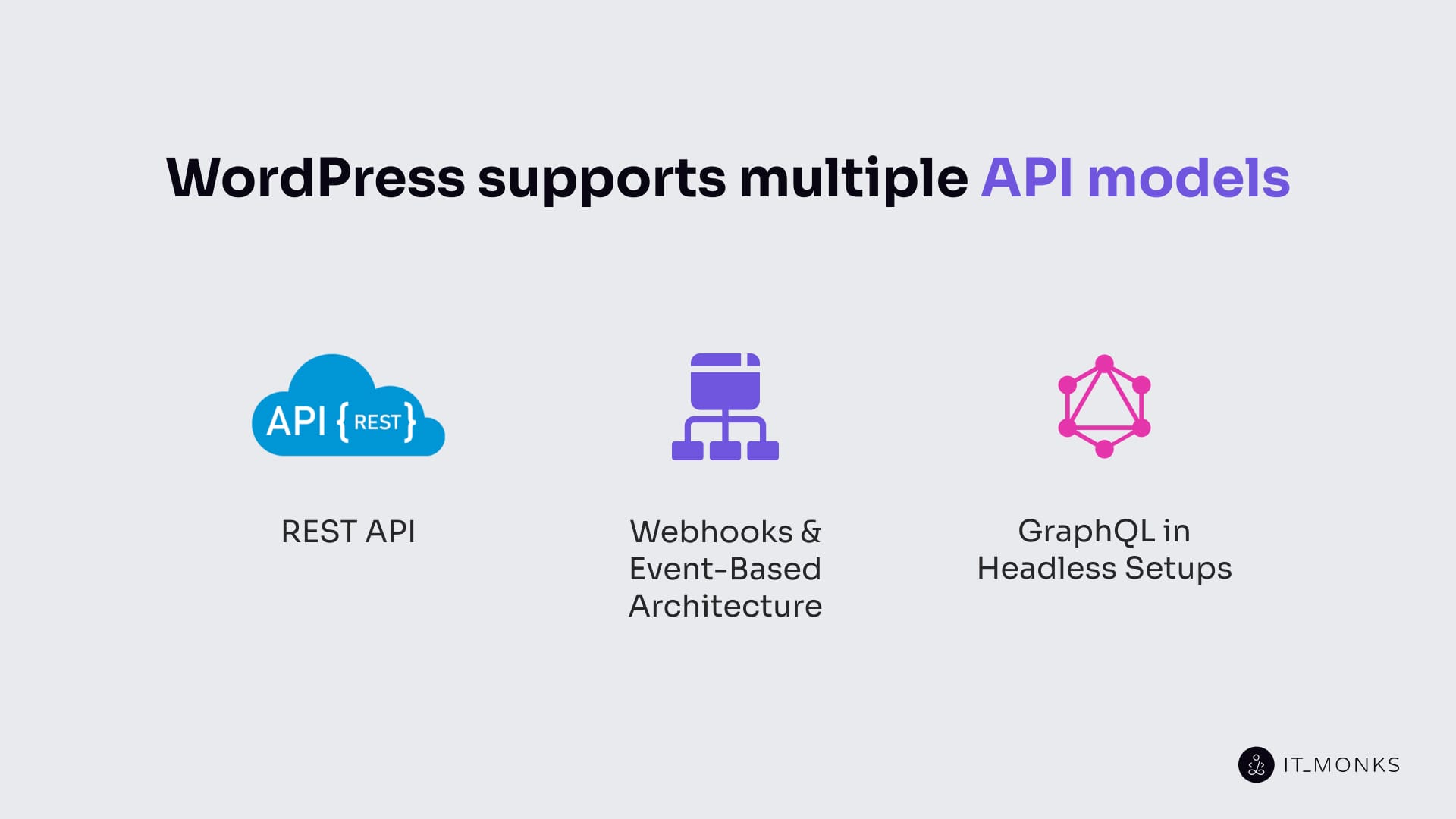
REST API – External Data Exchange
The WordPress REST API lets external systems interact with site data over HTTP using standard endpoints. It exposes key entities such as posts, pages, users, and settings, allowing remote apps to create, read, update, or delete content.
Typical use cases include:
- Mobile apps pulling posts from WordPress.
- Serverless functions updating site data.
- External dashboards syncing with WordPress content.
As a core part of backend architecture, the REST API ensures WordPress can serve as a content provider in distributed applications.
Webhooks – Event-Driven Communication
Webhooks provide event-driven callbacks that notify external systems when specific events occur in WordPress, such as publishing a post, updating a user, or modifying site settings. Instead of polling for updates, connected services receive real-time HTTP requests when events occur.
Examples of webhook use:
- Sending new form submissions to a CRM.
- Triggering a deployment pipeline after content updates.
- Automating notifications in tools like Slack or Zapier.
GraphQL – Headless WordPress
GraphQL is often used in headless WordPress setups, where the backend handles content while the frontend is built in another framework (React, Vue, Next.js, etc.). Unlike REST, GraphQL allows clients to request exactly the data they need using a schema-based query system.
Benefits of GraphQL in WordPress:
- Reduced data transfer by fetching only required fields.
- More flexible and predictable responses for custom frontends.
- Ideal for modern, decoupled architectures where WordPress serves purely as a content source.
Server-Side Infrastructure for WordPress Backend
The server-side infrastructure is the foundation of the WordPress backend, the environment where requests are processed, logic is executed, and content is delivered. This infrastructure typically includes three core layers:
- Web server (Apache or Nginx): receives incoming HTTP requests and routes them to the right resources.
- PHP runtime: executes WordPress’s backend logic, handling authentication, plugin functions, and admin processes.
- Database layer (MySQL or MariaDB): stores posts, users, settings, and metadata, and retrieves them when needed.
Every backend task (from logging in and saving posts to enforcing permissions and rendering admin screens) runs through this layered system before reaching the frontend.
Because the WordPress backend depends entirely on this infrastructure, its performance, security, and scalability are directly tied to server configuration. A reliable setup ensures smooth content delivery, secure access control, and consistent site behavior.
Performance Optimization in WordPress Backend
Performance optimization in the WordPress backend focuses on making system processes faster, leaner, and more reliable. It ensures that every request (from loading the dashboard to updating content) is handled efficiently, without unnecessary delays or server strain.
The backend processes run through three main layers:
- PHP execution – handles logic, plugins, and theme functions.
- Database queries – fetch posts, users, settings, and metadata.
- Role-based permissions – enforce access and security rules.
If any of these layers run inefficiently (e.g., due to excessive queries, heavy plugins, or unoptimized logic loops), the backend slows down. Optimizing these areas reduces latency, balances server load, and improves response times.
Key dimensions of backend performance include:
- Server efficiency – how well PHP and resources are managed.
- Query handling speed – minimizing slow or redundant database calls.
- Logic execution time – streamlining plugin and theme code.
- Scalability – keeping performance stable under high traffic.
Contact
Don't like forms?
Shoot us an email at [email protected]

Send a Project Brief
You need to load content from reCAPTCHA to submit the form. Please note that doing so will share data with third-party providers.
More InformationYou are currently viewing a placeholder content from Turnstile. To access the actual content, click the button below. Please note that doing so will share data with third-party providers.
More InformationYou are currently viewing a placeholder content from Facebook. To access the actual content, click the button below. Please note that doing so will share data with third-party providers.
More InformationYou are currently viewing a placeholder content from Instagram. To access the actual content, click the button below. Please note that doing so will share data with third-party providers.
More InformationYou are currently viewing a placeholder content from X. To access the actual content, click the button below. Please note that doing so will share data with third-party providers.
More Information
